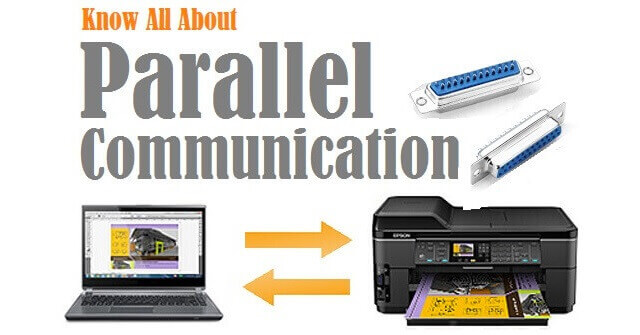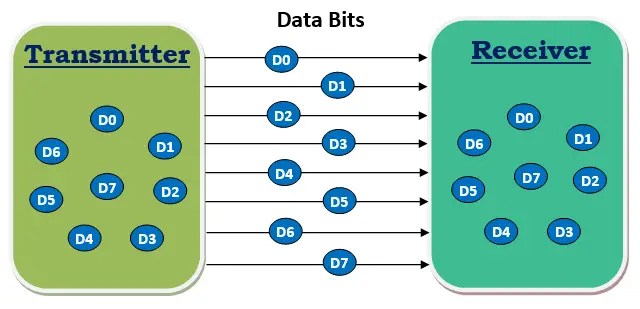Parallel Communication has been a popular choice when a high speed data transfer is required. This post entails Parallel Communication, evolution history, how it works, characteristics, When to use it and difference in Serial & Parallel Communication.
What is Parallel Communication
Parallel communication is a method of sending several data signals simultaneously over a transmission link at one time. It comprises of several wired channels in parallel.
In parallel mode of transfer, there is a onetime transfer of data from source to destination. This is possible using multiple channels for data transfer between transmitter and receiver.

Fig. 1 – Introduction to Parallel Communication
The basic difference between a parallel and a serial channel is its quantity of various wires in the physical form that is used for transmission of data between different devices. In contrast to serial transmission, Parallel data transfer uses more than one wire (and that is excluding the ground wire).
This mode of communication is expensive since it requires additional cables and hardware. Nevertheless, it is considered to be a swift mode of transfer. Printers, RAM, ISA, ATA, SCSI, PCI, Front side bus ,etc., use parallel data transmission.
Fig. 2 – Examples of Parallel Communication
The decreasing cost of integrated circuits and the increasing consumer demand for more data exchange speed has made it a suitable choice over Serial links.
Evolution History of Parallel Communication
It all started with the introduction of an 8 bit parallel port (also known as Standard Parallel Port) by IBM in 1981. It was introduced as a fast interface replacement for Dot Matrix printers. However, there was a major downside in this Standard Parallel Port (SPP). The downside was that it was only providing one directional communication i.e. from computer to Printer. A number of wires in the parallel port were left unused, which could have been utilized for indicating the status of printer.
On realization of various benefits of bi-directional communication, IBM made some upgradations and brought a parallel port that supported both ways data transfer. In spite of these upgradations, parallel data communication was yet to make a mark as a suitable high speed data port. It still had various downsides such as lack of standardization in physical interfaces and limited distance (six feet) supportability.
To overcome these downsides, a standard IEEE 1284 was introduced for parallel communication. IEEE 1284 standardizes the physical interfaces to ensure better inter-operable conditions for parallel interfaces. Its introduction nullified various drawbacks of initial parallel ports such as ensuring data integrity and communication supportability up to 30 feet.
Fig. 3 – Comparison between SPP and EPP in Parallel Communication
The Parallel ports became more advanced with the introduction of Enhanced Parallel Port (EPP) protocol. This protocol uses the data cycles more effectively and provides data transfer in real time. EPP remarkably increased the speed of parallel ports from 150 kbps to 2 mbps.
How Parallel Communication Works
In parallel communication, many bits (normally 8 bits or multiples of it) are transferred at the same time on various parallel paths (wires) within the same cable in synchronization with a single clock. The clock provides the timing for transmission as a constant clocking signal through the parallel paths.
Fig. 4 – Parallel Communication – Data Flow through Parallel Paths
As many bits are transferred over various parallel paths at the same time, the order of received bit strings may be different or out of sync subject to various factors such as source distance, location and available bandwidth. An example of this is distortion/ skipping in internet calls (VOIP) and video streaming.
Characteristics of Parallel Communication
Before the development of high speed serial communication technologies, the selection of parallel links against serial communication links was decided by following characteristics:
High Speed Data transfer
The data exchange speed of a parallel communication data link is equivalent to the multiplication of the number of parallel paths and the number of bits processed at a unit time. Therefore, the more is the parallel path, the higher is the achieved data transfer speed.
Limited Cable Length
As the length of cable increases, so does the amount of metal wires. This increases the chances of Cross-talk. Cross-talk means interference between the cable wires and it leads to the unsuccessful exchange of readable data (garbage value).
Due to this effect, we cannot increase the length of cable beyond a certain safe limit. Owing to this factor, the cable length supported by a parallel link is quite shorter than serial links.
Easy Installation
Parallel data links are relatively easy to be installed as hardware, which in turn makes them a reasonable choice. The configuration of a parallel port in a PC is quite easy as compared to its counterpart ‘Serial links’.
It is because almost all serial links require its conversion into a parallel form using a Universal asynchronous receiver transmitter to enable it to be connected with a data bus directly.
When to Use Parallel Communication
It should be used when:
- Large Data needs to be transferred.
- Data to be sent is time sensitive.
- Data is required to be transferred quickly or in real time.
Differences between Serial Communication and Parallel Communication
The differences between Serial and Parallel communication are as follows:
- No of paths for Data transfer: Serial link has only one path for data transfer while Parallel one has multiple paths.
- Distance Coverage: Serial link supports communication to long distances while Parallel data transmission supports limited distance transmission.
- Cross-talk: Chances of Cross-talk is less in Serial link compared to Parallel one due to only one path available.
- Speed: Serial link is slow compared to Parallel one.
- Communication: Serial transmission is full duplex as data can be sent or received at either ends. Parallel data is half duplex as the data can either be sent or received.
- Cost Factor: Serial links are cheaper than Parallel one owing to more paths in parallel mode.
- Complexity: Serial links are simple and reliable while Parallel links are complex and unreliable.
Also read: Communication Protocols in Embedded Systems – Types, Advantages & Disadvantages Digital Communication – Introduction, Basic Components, How Signal Process Works and Advantages Serial Communication – Protocols, Standards and Advantages



